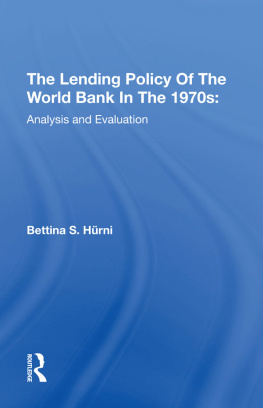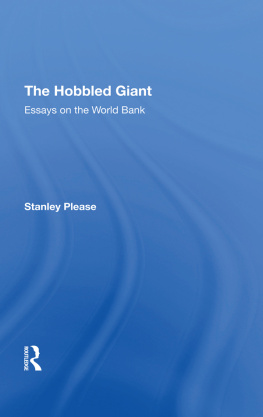The Lending Policy of the World Bank in the 1970s
Other Titles in This Series
Oil Money and the World Economy, Yoon S. Park
The New International Economic Order, edited by Karl P. Sauvant and Hajo Hasenpflug
International Business in the Middle East: Case Studies, edited by Ashok Kapoor
The Sogo Shosha: Japans Multinational Trading Companies, Alexander K. Young
Debt and the Less Developed Countries, edited by Jonathan David Aronson
Kuwait: Trade and Investment, Ragaei El Mallakh
Foreign Investments and the Management of Political Risk, Dan Haendel
U. S. -Mexico Economic Relations: Current Issues and Future Prospects, edited by Barry W. Poulson and T. Noel Osborn
Extraterritorial Antitrust: The Sherman Act and U.S. Business Abroad, James B. Townsend, Jr.
International Trade and Agriculture: Theory and Policy, edited by Jimmye S. Hillman and Andrew Schmitz
Japan and the United States: Economic and Political Adversaries, edited by Leon Hollerman
Westview Special Studies in International Economics and Business
The Lending Policy of the World Bank in the 1970s: Analysis and Evaluation
Bettina S. Hrni
This pilot study the first to analyze the World Banks lending policy in the Second United Nations Development Decade concentrates on the Banks shift in emphasis from traditional infrastructure projects to new style projects, especially in the area of rural development, and on the resulting changes in lending criteria in the 1970s. Basing her conclusions on two years of independent research and access to confidential materials, Dr. Hrni evaluates the World Banks work; gives a good overall view of current development problems including implementation of the growth with equity strategy and their possible solutions; shows the effects of the new development goals in borrower and creditor countries, as well as on the institutional decision-making process; and offers recommendations for improvement of the Banks evaluation methodology and operational structures. She presents a clear picture of the positive and negative aspects of the World Bank as a multilateral investment model and shows its bridge-building function in the great North-South controversy.
Bettina S. Hrni is a research fellow with the Swiss Ministry of Finance. Dr. Hrni has taught international economics at Geneva University and the University of St. Gallen and, as a recipient of a Swiss National Science Foundation grant, was a visiting fellow at the World Bank for two years.
First published 1980 by Westview Press
Published 2019 by Routledge
52 Vanderbilt Avenue, New York, NY 10017
2 Park Square, Milton Park, Abingdon, Oxon OX14 4RN
Routledge is an imprint of the Taylor & Francis Group, an informa business
Copyright 1980 by Bettina S. Hrni
All rights reserved. No part of this book may be reprinted or reproduced or utilised in any form or by any electronic, mechanical, or other means, now known or hereafter invented, including photocopying and recording, or in any information storage or retrieval system, without permission in writing from the publishers.
Notice:
Product or corporate names may be trademarks or registered trademarks, and are used only for identification and explanation without intent to infringe.
Library of Congress Cataloging in Publication Data
Hrni, Bettina S
The lending policy of the World Bank in the 1970s.
(Westview special studies in international economics and business)
Bibliography: p.
1. International Bank for Reconstruction and Development. I. Title. II. Series.
HG3881.H84332.15379-16385
ISBN 13: 978-0-367-29350-5 (hbk)
To My Parents
The present study was undertaken independently, thanks to a three-year research grant from the Swiss National Science Foundation (Schweizerischer Nationalfonds zur Frderung der wissenschaftlichen Forschung) from November 1976 to November 1979. I wish to thank the foundation for enabling me to undertake this research and also my two project directors, Professors Franz Aschinger and Jacques Freymond. I owe a special debt of gratitude to the foreign consultant on my project to the foundation, Professor Hanns Pichler. The enriching experience of World Bank staff hospitality deserves special mention here. Although numerous staff members were ready to help me in their fields of expertise, my freedom of thought was in no way impaired. The World Bank as an institution deserves credit for the objectivity of its staff toward an outsider. A special word of sincere thanks goes to John E. Merriam, director of the Information and Public Affairs Department, and to Pastor B. Sison for their invaluable technical and administrative help and great moral support. My thanks go to the whole staff of this department, who were all very kind to me. I am indebted to Heinz Bachmann and all Swiss Bank staff members for their interesting discussions and comments on my work and their practical help. My thanks also go to Wouter Tims, Attila Karaosmanoglu, Mervyn Weiner, Dragoslav Avra-movie, Montague Yudelman, Burke Knapp, Anandarup Ray, Hans Janssen, Munir Benjenk, and to senior consultants like Professors Klaus Billerbeck, Paul Streeten, and Goran Ohlin. From outside the Bank, I received valuable advice from Robert Asher, Joseph Yager, Sidney Weintraub, James Grant, Ross Coggins, Hans-Helmut Taake, and Allan Olson. Special tribute must be paid to Ambassador and Mrs. Raymond Probst and Ambassador Klaus Jacobi for their constant encouragement. Last but not least, I am obliged to Goddard Winterbottom and his staff for all their practical help and to Azucena P. Zorrilla for her patience in typing the manuscript. The author alone is responsible for the views expressed in this postdoctoral study, which was encouraged by the University of St. Gallen, Switzerland, where the author has been lecturing in international economics in addition to teaching at Geneva University.
B.S.H.
There are many ways of looking at an institution such as the World Bank, but two are of special interest in introducing this book. We may look at the Bank as a snapshot, an image of one particular moment, or we may look at it as a film, a process over time. Many critics of the Bank see it as a still, compare it with their fantasy of a pinup Bank, and, not surprisingly, find it deficient. A more historical approach would trace performance against changing ideals and changing responses to experience. The same gap between ideal and reality looks quite different according to whether it is regarded as a static shortfall or a dynamic lag in response. Dr. Hrnis merit is that she does take a historical approach and traces the second-generation problems to which the first generation has given rise.
Dr. Hrni, in this book, sets the evolution of Bank lending policy into the larger framework of the evolution of development thinking and experience. Her critique, therefore, has to be taken more seriously than the criticisms of those who think that everything is for the best (or at least the second-best) in the best of all possible (or at least feasible) world banks and of those who believe the Bank is an agent of U.S. imperialism or, for that matter, of alien communism.
Dr. Hrni appraises the shift of emphasis in Bank lending from infrastructure, via agriculture and education, to rural development and poverty eradication. Her work is illuminating on what might well be the motto of the Bank, borrowed but adapted from Tom Lehrers song, doing well by doing good, or how to be hard-nosed without being hard-boiled.



